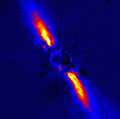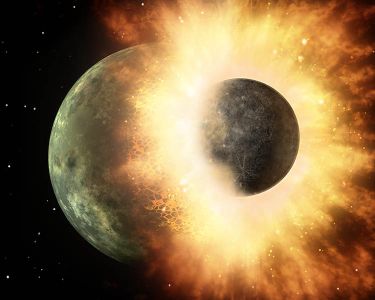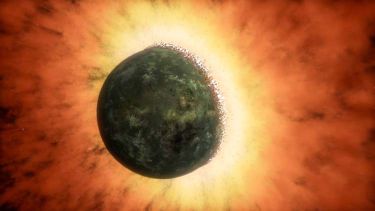HD 172555 / HR 7012

HD 172555 / HR 7012 |

|
|
| Home | Stars | Habitability | Life | |
 ESO
-- larger image
ESO
-- larger image
Encircled by dust like Beta Pictoris,
HD 172555 is a bluish white star that is
hotter, brighter, and more massive than
our Sun, Sol. (See Sloan Digital Sky
Survey field
images of
HD
172555 from
WikiSky.org.)
System Summary
This star system is located about 95.3 light-years (ly) away from our Sun, Sol. It lies in the west central region of (18:45:26.9-64:52:16.5, ICRS 2000.0) of Constellation Pavo, the Peacock -- west of Delta Pavonis and Beta Pavonis, southwest of Peacock (Alpha Pavonis), east of Eta Pavonis, northeast of Atria (Alpha Trianguli Australis), and northwest of Epsilon Pavonis. The star appears to be member of the 12-million-year-old Beta Pictoris Association, or "Moving Group" (LÚpine and Simon, 2009; Rebull et al, 2008; Ortega et al, 2004; Weinberger et al, 2003; and Zuckerman et al, 2001). While dust has been detected around HD 172555, no substellar companion objects have been found as of August 2009. On August 10, 2009, astronomers using the infrared Spitzer Space Telescope announced observational evidence for a recent planetary collision around this star (Spitzer press release; Rachel Courtland, New Scientist, August 11, 2009; and BBC News, August 11, 2009).
 SSC,
JPL,
Caltech,
NASA
SSC,
JPL,
Caltech,
NASA
Larger animation still.
Dust and other debris observed
around HD 172555 suggest that
a planetary collision involving
objects roughly the size of
Mercury and the Earth's Moon
-sized objects occurred within
the past million years
(more).
Today, some astronomers now refer to this star as HD 172555, as it is listed in the Henry Draper (1837-82) Catalogue with extension (HDE), a massive photographic stellar spectrum survey carried out by Annie Jump Cannon (1863-1941) and Edward Charles Pickering (1846-1919) from 1911 to 1915 under the sponsorship of a memorial fund created by Henry's wife, Anna Mary Palmer. As a relatively bright star in Earth's night sky, the star is also catalogued as Harvard Revised (HR) 7012, a numbering system derived from the 1908 Revised Harvard Photometry catalogue of stars visible to many Humans with the naked eye. The HR system has been preserved through its successor, the Yale Bright Star Catalogue -- revised and expanded through the hard work of the late E. Dorrit Hoffleit (1907 - 2007) and others.
The Star
HD 172555 is a star of spectral and luminosity type A5-7 V-IV that may have already evolve off the main sequence into a subgiant (NASA Stars and Exoplanet Database; and SIMBAD). The star may have around 1.7 times Sol's mass (NASA Stars and Exoplanet Database; and David F. Gray, 1992), around 1.55 +/- 0.07 times Sol's diameter (NASA Stars and Exoplanet Database; and Kenneth R. Lang, 1980); and around 7.8 times its theoretical bolometric luminosity (NASA Stars and Exoplanet database; and Kenneth R. Lang, 1980). It may be as young as 12 million years old (Spitzer press release; and Zuckerman et al, 2001). Useful star catalogue numbers for the star include: HR 7012, Hip 92024, HD 172555, CP-64 3948, SAO 254358, FK5 3489, and 2MASS J18452691-6452165.
The orbital distance from HD 172555 where an Earth-type planet currently would be "comfortable" with liquid water is centered near 2.8 AU -- between the orbital distances of Earth and Mars in the Solar System. At that distance from the star, such a planet would have an orbital period around 3.6 years. It would be very difficult for astronomers to detect with today's astronomical instruments and methods.
 SSC,
JPL,
Caltech,
NASA
SSC,
JPL,
Caltech,
NASA
Larger animation still.
The collision pulverized the Moon-sized
object and sent shockwaves that also sent
rocky debris from the larger Mercury-sized
object in space around HD 172555, including
the recently detected Silicon Monoxide gas,
melted rock as glassy substances like
obsidian and tektites, and rocky rubble
(more).
Dust
Infrared excess from dust particles of minimum silicate, carbon, and silica sizes of 0.9, 1.2, and 1.3 micrometers was detected around HD 172555 (Chen et al, 2008; Rebull et al, 2008; Chen et al, 2006); and Weinberger et al, 2003). No planetary or brown dwarf companions have been founded as yet (Lagrange et al, 2009).
Closest Neighbors
The following star systems are located within 10 light-years, plus more bright stars within 10 to 20 ly, of HD 172555.
| Star System | Spectra & Luminosity | Distance (light-years) |
| ... | ... | 0-10 |
| * plus bright stars * | . . . | |
| CD-66 2307 | K3-5 VI-III | 12 |
| CP-65 3528 AB | F8 V ? | 20 |
Other Information
Up-to-date technical summaries on this star can be found at: the NASA Stars and Exoplanet Database; and SIMBAD. Additional information may be available from www.alcyone.de as HR 7012. More recent research papers may become available at the SAO/NASA ADS.
Observable only in the southern hemisphere, Constellation Pavo is located between Telescopium to the north and Octans to the south. For more information about the stars and objects in this constellation, go to Christine Kronberg's Pavo. For an illustration, see David Haworth's Pavo.
For more information about stars including spectral and luminosity class codes, go to ChView's webpage on The Stars of the Milky Way.
© 1998-2009 Sol Company. All Rights Reserved. |